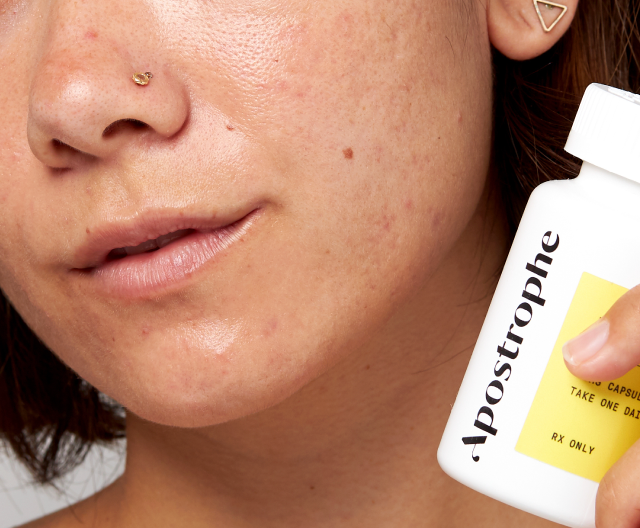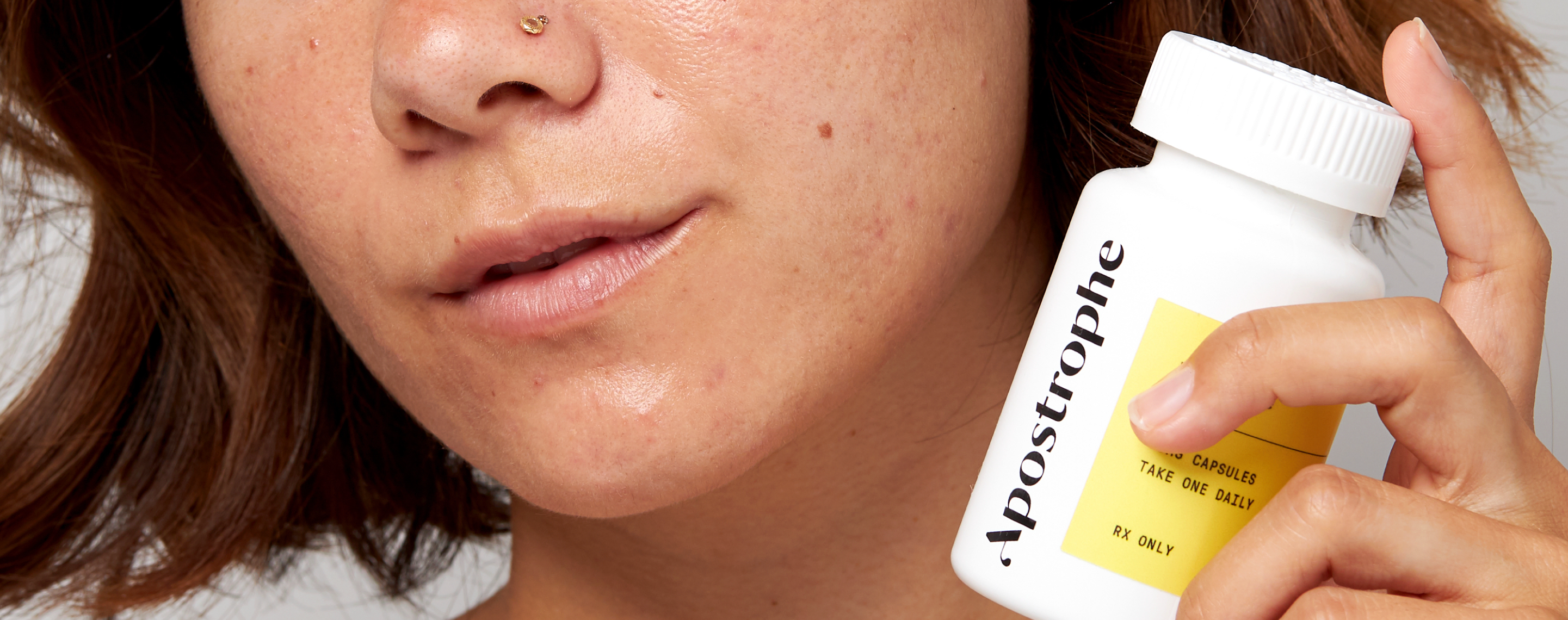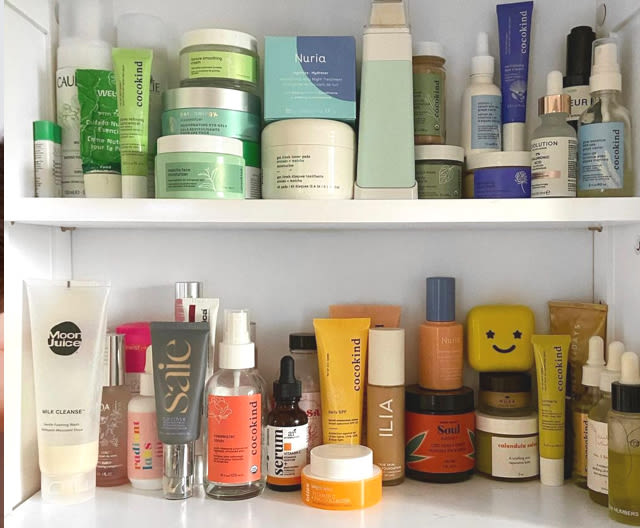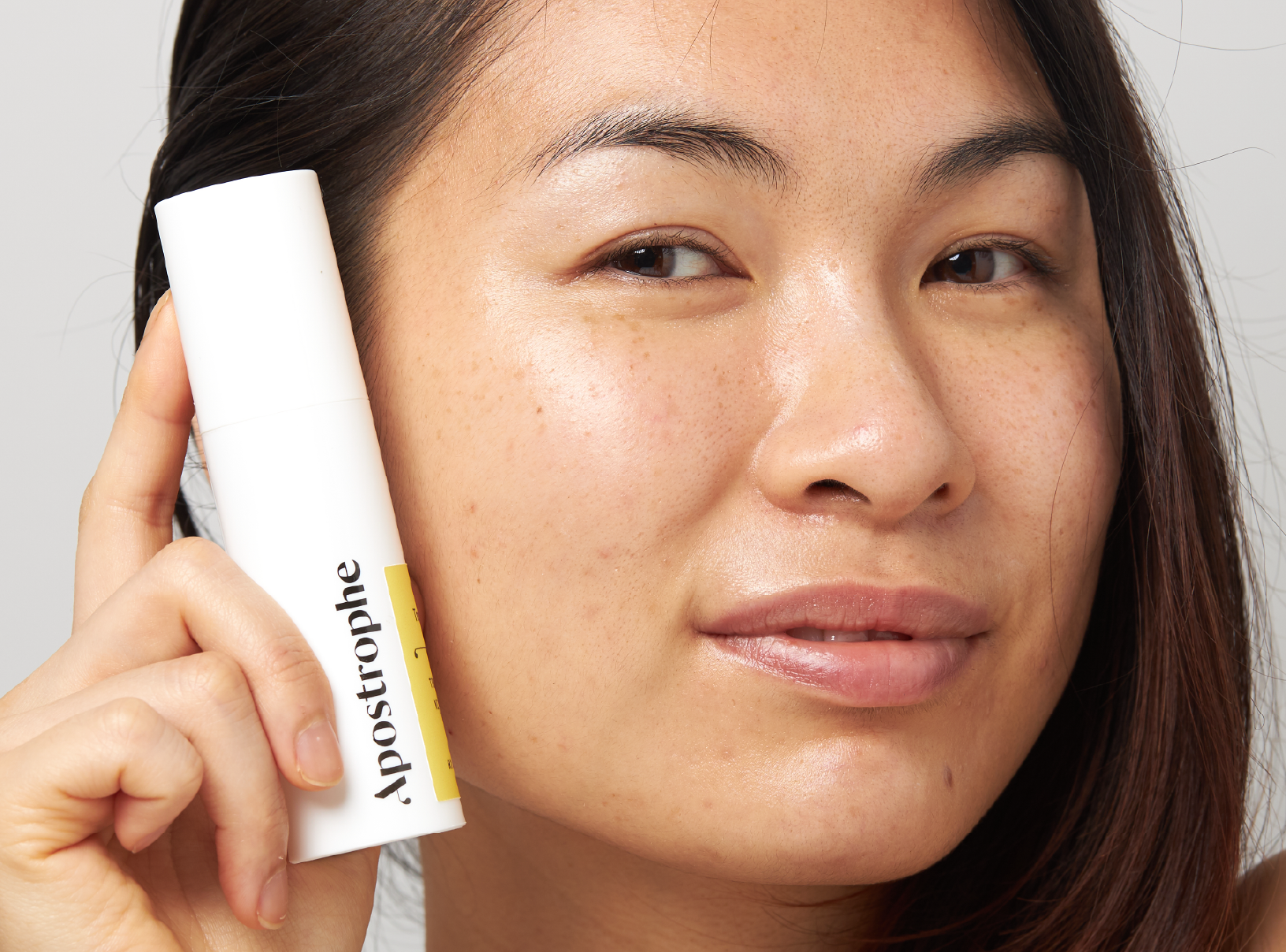Education
How Long Does It Take For Spironolactone To Work?


SHARE
Education
How Long Does It Take For Spironolactone To Work?
Medically reviewed by Aimee Paik, MD
Written by Apostrophe Team
Last updated 1/2/2023
How Long Does it Take for Spironolactone to Work?
Battling acne is never easy. Sometimes it feels like you’ve tried everything—from antibiotics to the trendiest internet remedies—only to wake up disappointed that your acne has returned. But before you reach for yet another vitamin regimen or diet fad, consider talking to your doctor about spironolactone, a tried-and-true treatment that’s been shown to manage and prevent hormonal cystic acne.
And the best part? You don’t have to go on this journey alone. In this post, we’ll walk you through all you need to know about spironolactone, including:
What it is
How you take it
How long you need to be on it
How you know it’s working
Any possible side effects
Learn about the spironolactone treatment and be on your way to rediscovering your healthy skin.
What Is Spironolactone?
In technical terms, spironolactone is a potassium-sparing diuretic. Originally prescribed as a blood pressure medication, spironolactone’s value also lies in its androgen-blocking capabilities. This is important because an excess of androgens—a class of hormones—can stimulate oil production in your pores, leading to acne. Spironolactone is branded in the U.S. as Aldactone.
Other characteristics include:
It’s used to treat hyperaldosteronism, which is the excess production of the hormone aldosterone.
It’s become more popular as a prescribed treatment for acne from hormonal imbalance in women. This is because it regulates the production and fluctuation of hormones particularly involving androgens. It’s also a great way to treat acne without relying on antibiotics.
It generally takes two to three months to start seeing improvements.
Although oral spironolactone is not administered to cis or trans men utilizing hormonal therapies because it disrupts androgens (male sex hormones), topical forms are safe for all genders. Topical spironolactone has been shown to be effective. In one study using a 5% spironolactone cream, 30% of patients saw a complete regression of acne and 65% saw a marked improvement.
How Do I Take It?
As stated above, though both oral and topical forms of spironolactone are available, cis and trans men using hormonal treatments should only take the topical form in conjunction with other acne ingredients. Let’s break down the characteristics of oral and topical spironolactone even further.
Oral Spironolactone
Working from the inside out to treat and prevent hormonal acne, oral spironolactone should be taken once or twice daily in doses of 25-100 mg. By decreasing testosterone levels and blocking androgen receptors in women, oral spironolactone prevents excessive sebum production. Androgens also have a direct effect on clogging pores so oral spironolactone can help prevent the development of blackheads and whiteheads.
When taking this medication, it’s important to remember the following:
Be consistent in taking it for best results and to minimize side effects. For instance, you can take spironolactone either in the morning or at night, but be sure to take it around the same time each day.
It can be taken with or without food. Additionally, taking spironolactone with food can help prevent nausea and drinking plenty of water throughout the day can reduce dizziness.
As it affects your hormones, taking a birth control pill while taking spironolactone can help regulate periods and prevent spotting.
It’s recommended that you use spironolactone in conjunction with contraceptives and other acne treatments. It’s important that you not become pregnant on spironolactone because of the risk of birth defects. Spironolactone should be used in conjunction with other topical acne treatments as it will reduce the amount of oral spironolactone you need.
Avoid taking it before bed time as it is a diuretic and can cause you to visit the bathroom more often. A good time to take it is right after dinner.
As mentioned above, taking oral spironolactone with your birth control may be the most effective way to fight back against hormonal acne. Because birth control pills can also help clear skin, the two treatments can work side-by-side to help you achieve your skincare goals.
If you’re unable to take hormonal birth control to treat acne, spironolactone still works well on its own.
Topical Spironolactone
If you identify as a cis or trans man or are unable to tolerate oral spironolactone’s systemic side effects, consider trying topical spironolactone. Currently only widely available through Apostrophe, topical spironolactone helps with the causes of hormonal acne at the skin level. It works best when used in conjunction with other top acne fighting ingredients such as tretinoin and topical clindamycin.
What’s more, you only need to spread one pea-sized drop evenly over the entire face and massage gently to reap the full benefits. Let’s take a deeper look at how topical spironolactone is applied:
Start slow – Start using your treatment 2-3 times a week (Monday, Wednesday, and Friday) for two weeks. If your skin isn’t irritated after the first two weeks, you can increase application frequency to every other night for another two weeks. If your skin can tolerate frequent use, you can ramp up to nightly use.
Keep your routine simple – Avoid using extra products like toners and exfoliating acids until your skin can tolerate daily usage of topical spironolactone.
Pair with gentle skin care – Use a gentle cleanser and moisturizer to reduce potential dryness and irritation, and be sure to wear sunscreen when heading outside.
Apostrophe’s topical spironolactone has been shown to be particularly effective. Available in two main formulas, Apostrophe’s topical spironolactone can be customized according to your skin and concerns.
So, Which Form Is More Effective?
Depending on the dose, oral spironolactone is typically more effective than topical spironolactone. In sum:
Topical spironolactone works best when paired with other treatments. It can add a powerful punch to other acne-fighting formulas, but it might not be as effective by itself. It’s also better suited for individuals who aren’t a good candidate for oral spironolactone and those who want to avoid the potential risks of oral spironolactone.
Oral spironolactone is more effective since it reduces acne-causing sebum production from within your skin. You can also increase the dose to the amount needed for maximal results.
Rather than view one form of spironolactone as “more effective” than the other or as a replacement, they should be thought of as complements. For best results, if possible, you should use both oral and topical forms of spironolactone. While oral spironolactone is working from the inside out, topical spironolactone is working hard at the skin level to make sure new breakouts are kept in check.
How Long Do I Need to Be On It?
Although oral and topical spironolactone work in different ways to combat acne, they are similar in terms of the time required to see improvements.
For oral spironolactone, you should expect to see progress within 8-12 weeks of starting treatment, although this depends on your skin. We recommend checking in with your dermatologist every three months to review your progress and see if changes need to be made to your treatment plan.
With topical spironolactone, you should start to see improvements within 8-12 weeks. Additionally, Apostrophe’s spironolactone formulas are combined with potent skincare ingredients such as tretinoin and tranexamic acid. These formulations help your skincare regimen target other issues, such as signs of aging and hyperpigmentation.
Regardless of which form of spironolactone you take, it’s important to remember that no treatment will lead to instant, overnight improvements. For best results, you should use these medications consistently and follow your dermatologist’s recommendations.
What Happens If I Stop Taking Spironolactone?
Using both oral and topical spironolactone effectively prevents hormonal acne’s return. If you stop both forms of spironolactone, you can expect acne to return in a few weeks or even days. You should stop taking spironolactone only with your dermatologist’s advice.
How Do I Know If Spironolactone Is Working?
As with most acne treatments, you’ll know spironolactone is working after experiencing fewer breakouts and less oily skin.
What Side Effects Does Spironolactone Have?
Although many people are fine on spironolactone, it’s important to remember that any medication can come with side effects. Let’s take a further look at any potential side effects.
Oral Spironolactone
Possible side effects of taking oral spironolactone include:
Going to the bathroom more (spironolactone is a diuretic).
Changes in menstrual cycle (spotting).
Breast tenderness and enlargement.
Increased potassium levels—although highly unlikely in young patients without underlying medical conditions, it’s wise to check in periodically with your doctor
Fatigue, headaches, and dizziness.
Birth defects. As a result, spironolactone isn’t recommended for pregnant women.
Topical Spironolactone
Whereas oral spironolactone shouldn’t be taken by cis men, topical spironolactone can be used by everyone. Topical spironolactone has no systemic side-effects, but you may experience some redness, peeling, general irritation in the first few weeks of use.
Choose Clear Skin with Apostrophe
When nothing seems to be working against your hormonal cystic acne, it may be time to try oral or topical spironolactone.
Fortunately, Apostrophe’s got you covered. With doctors in 40 states, getting a prescription for spironolactone has never been easier. All you have to do is create an account, fill out an intake survey, and let your Apostrophe doctor or healthcare provider take care of the rest.
Shop this post

Topical Spironolactone

Oral Spironolactone
Like what you just read? Sign up for our email list to get the scoop on skincare science delivered straight to your inbox.

Education
What is milia?
What is milia? Today, we’re jumping into one type of bump that you may have heard about most commonly in infants — milia.
Read More
Education
Best moisturizer for acne-prone skin
If you have combination acne-prone skin, figuring out which moisturizer is best for your skin might be tough. In this guide, we break down the best moisturizer for combination, acne-prone skin.
Read More
Education
How to build a face care routine
As you get into skincare, it might seem overwhelming, especially trying to figure out the order you're supposed to apply products in. Below, we detail how to build a face care routine for your skin!
Read More
